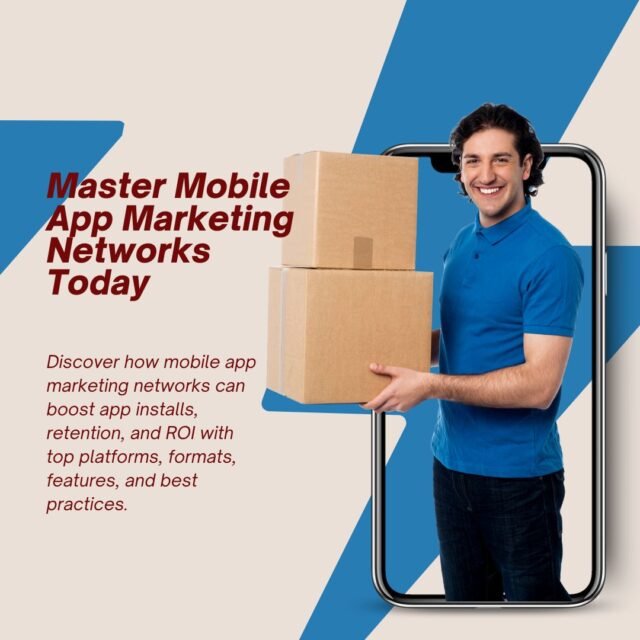Mobile app marketing networks are revolutionizing the way developers promote their apps, connect with users and cultivate growth. When millions of apps are clamoring for attention, these networks become the difference between an app that flourishes and an app that fails. To help give you some ideas on how you can turn around your own apps marketing strategy for the better, this guide will talk about all aspect of mobile app marketing networks: what they are, their different flavors, how to tell which one is right for your particular needs, and some best practices that have been successful in recent times.
WHAT IS A MOBILE APP MARKETING NETWORK?

In other words, a mobile app marketing network is a service that brings together users (apps suppliers) and destinations (ad spaces) to promote mobile applications. One key asset for these networks is their multi-ad format support – enabling advertisers to assertively access precise target groups through a variety of ad formats such as banner ads, video or interstitials. These networks–whether tracking app installs, bringing in new paying customers or promoting target overall sales–are instrumental in securing more bang for an app’s marketing buck.
But why are mobile app marketing networks important? With over three million apps available today on Google Play alone, the competition is fierce. In addition to creativity, getting the right tools and platforms of engagement for that creative output is required. This is where mobile app marketing networks come into play, providing solutions to enable maximum impact and return on investment.
TYPES OF MOBILE APP MARKETING NETWORKS
A. Incentivized Networks
How they work: Users are given a reward (e.g., in-app currency or discounts) for carrying out specific actions such as downloading an app or producing a certain number of game points.
Who benefits most: These networks are the most suitable means for apps to reach mass installations.
Pros:
- Rapid user installation outreaches
- Helps to increase app visibility
Cons: - Higher attrition as rewarded users often uninstall their app afterwards
Example platforms: Fyber, Tapjoy
B. Non-Incentivized Networks
How they work: Users are shown ads, but they are not incentivized for their viewing. With no hidden costs, these networks provide the most genuine traffic. They focus on attracting people genuinely interested in your app.
Who benefits most: Apps that provide an accurate service and want to get high quality, long-term users.
Pros:
- Higher engagement and retention rates
- Genuine interest from users
Cons: - Lower conversion rates compared to incentivized networks
Example Platforms: Google Ads, Facebook Ads
C. Social Media Ad Networks
How they work: Devices such as Instagram, TikTok, and Snapchat have ad platforms built into them for developers to buy. Developers can push their apps straight into the user’s feed or story.
Who benefits most: Apps that have big imagery and/or material which might be shared to very young people.
Pros:
- Creative ways such as stories and reels
- Precise targeting
Cons: - Performance fluctuates depending on industry and creativity of app messages
D. Affiliate or Performance-Based Networks
How they work: Advertisers will only pay publishers for specific actions, such as acquiring new customers or sales.
Who benefits most: Apps targeting an ROI model strictly.
Pros:
- Budget-friendly, focused on performance
- Optimal choice for CPI (cost per install) campaigns
Cons: - Finding a good affiliate partner takes time
Example Platforms: Admitad, ClickDealer
The Most Important Features to Look For in Mobile App Marketing Networks
- Sophisticated Targeting
Target users based on demographics, device type, location, and interests. - Comprehensive Reporting and Analytics
Understand performance indicators like CTR, CPIs, and LTV. - Pricing Options to Meet Your Needs
- CPI (Cost-per-install): Ideal for driving downloads
- CPA (Cost-per-action): Good for performance-driven campaigns
- CPC (Cost-per-click): Useful for landing page traffic
- Ad Format Variety
Use video, native, and playable ads for better engagement. - Compatibility and Integration
Ensure support for iOS and Android, and seamless analytics tool integration.
Top Mobile App Marketing Networks
- Google Ads
Pros: Wide reach, advanced targeting
Cons: Can be expensive if not optimized - Facebook Ads
Pros: Rich user data, excellent targeting
Cons: High competition, costly CPM - TikTok Ads
Pros: High engagement through short videos
Cons: Performance depends on app type - AppLovin
Pros: Result-oriented app campaigns
Cons: Limited social engagement features - Unity Ads
Pros: Perfect for gaming apps with playable ads
Cons: Less suited for non-gaming apps
Best Practices for Using Mobile App Marketing Networks
- Optimize Your App Store Page
Strong visuals, reviews, and descriptions matter. - Start Small with A/B Testing
Test different creatives, formats, and targeting before scaling. - Focus on Retention, Not Just Installs
Choose networks that attract users who stay. - Always be Optimizing
Constantly adjust based on performance and ROI.
The Future of Mobile App Marketing Networks

Mobile app marketing networks are evolving with AI, privacy-first strategies, and immersive formats like AR. Stay informed, be adaptable, and take proactive steps now to stay ahead of the competition.




